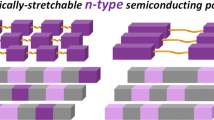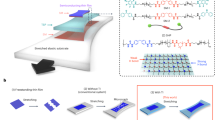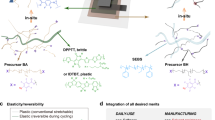Abstract
Main-chain engineering and side-chain engineering approaches used to design and synthesize semiconducting polymers with intrinsic ductility and/or stretchability are introduced in this review, and recent progress in this area is discussed. Main-chain engineering includes (a) conjugation-break spacer (CBS), (b) ternary copolymer, and (c) block copolymer approaches, and side-chain engineering includes (d) Y-shaped side chain, (e) graft copolymer, and (f) cross-linking approaches. A summary of the results obtained by approaches (a)–(f) demonstrates that approaches (a) and (d) tend to provide high charge mobilities (>1 cm2V−1s−1) even at 100% tensile strain. On the other hand, the mechanical properties of films prepared by these methods remain poor, with a high elastic modulus in the range of >0.1 GPa, which causes poor film ductility and stretchability. In contrast, ductile and/or elastic semiconducting materials with extremely low elastic moduli of <0.01 GPa are obtained by approaches (c) and (f), which are used to prepare thermoplastic and cross-linked elastomeric materials, respectively. For semiconducting polymers to be promising candidates in applications such as wearable electronics, electronic skins, and bioelectronics, the trade-off relationship between the electronic and mechanical performance of semiconducting polymers must be prevented by further developing and combining versatile and efficient approaches.
This is a preview of subscription content, access via your institution
Access options
Subscribe to this journal
Receive 12 print issues and online access
$259.00 per year
only $21.58 per issue
Buy this article
- Purchase on Springer Link
- Instant access to full article PDF
Prices may be subject to local taxes which are calculated during checkout








Similar content being viewed by others
References
Someya T, Bao Z, Malliaras GG. The rise of plasticbioelectronics. Nature. 2016;540:379–85.
Kim DH, Lu N, Ma R, Kim YS, Kim RH, Wang S, et al. Epidermal electronics. Science. 2011;333:838–43.
Kaltenbrunner M, White MS, Głowacki ED, Sekitani T, Someya T, Sariciftci NS, et al. Ultrathin and lightweight organic solar cells with high flexibility. Nat Commun. 2012;770:1–7.
Root SE, Savagatrup S, Printz AD, Rodriquez D, Lipomi DJ. Mechanical properties of organic semiconductors for stretchable, highly flexible, and mechanically robust electronics. Chem Rev. 2017;117:6467–99.
Wang GJN, Gasperini A, Bao Z. Stretchable polymer semiconductors for plastic electronics. Adv Electron Mater. 2018;4:1700429.
Ray TR, Choi J, Bandodkar AJ, Krishnan S, Gutruf P, Tian L, et al. Bio-integrated wearable systems: a comprehensive review. Chem Rev. 2019;119:5461–533.
Someya T, Amagai M. Toward a new generation of smart skins. Nat Biotechnol. 2019;37:382–8.
Tran H, Feig VR, Liu K, Zheng Y, Bao Z. Polymer chemistries underpinning materials for skin-inspired electronics. Macromolecules. 2019;52:3965–74.
Yang JC, Mun J, Kwon SY, Park S, Bao Z, Park S. Electronic skin: recent progress and future prospects for skin-attachable devices for health monitoring, robotics, and prosthetics. Adv Mater. 2019;31:e1904765.
Ashizawa M, Zheng Y, Tran H, Bao Z. Intrinsically stretchable conjugated polymer semiconductors in field effect transistors. Prog Polym Sci. 2020;100:101181.
Chen AX, Kleinschmidt AT, Choudhary K, Lipomi DJ. Beyond stretchability: strength, toughness, and elastic range in semiconducting polymers. Chem Mater. 2020;32:7582–601.
Xu J, Wang S, Wang GJN, Zhu C, Luo S, Jin L, et al. Highly stretchable polymer semiconductor films through the nanoconfinement effect. Science. 2017;355:59–64.
Mun J, Kang J, Zheng Y, Luo S, Wu HC, Matsuhisa N, et al. Conjugated carbon cyclic nanorings as additives for intrinsically stretchable semiconducting polymers. Adv Mater. 2019;31:1903912.
Zhao Y, Zhao X, Zang Y, Di C, Diao Y, Mei J. Conjugation-break spacers in semiconducting polymers: impact on polymer processability and charge transport properties. Macromolecules. 2015;48:2048–53.
Melenbrink EL, Hilby KM, Alkhadra MA, Samal S, Lipomi DJ, Thompson BC. Influence of systematic incorporation of conjugation-break spacers into semi-random polymers on mechanical and electronic properties. ACS Appl Mater Interfac. 2018;10:32426–34.
Melenbrink EL, Hilby KM, Choudhary K, Samal S, Kazerouni N, McConn JL, et al. Influence of acceptor side-chain length and conjugation-break spacer content on the mechanical and electronic properties of semi-random polymers. ACS Appl Polym Mater. 2019;1:1107–17.
Mun J, Wang GJN, Oh JY, Katsumata T, Lee FL, Kang J, et al. Effect of nonconjugated spacers on mechanical properties of semiconducting polymers for stretchable transistors. Adv Funct Mater. 2018;28:1804222.
Galuska LA, McNutt WW, Qian Z, Zhang S, Weller DW, Dhakal S, et al. Impact of backbone rigidity on the thermomechanical properties of semiconducting polymers with conjugation break spacers. Macromolecules. 2020;53:6032–42.
Oh JY, Rondeau-Gagné S, Chiu YC, Chortos A, Lissel F, Wang GJN, et al. Intrinsically stretchable and healable semiconducting polymer for organic transistors. Nature. 2016;539:411–5.
Zheng Y, Ashizawa M, Zhang S, Kang J, Nikzad S, Yu Z, et al. Tuning the mechanical properties of a polymer semiconductor by modulating hydrogen bonding interactions. Chem Mater. 2020;32:5700–14.
Printz AD, Savagatrup S, Burke DJ, Purdya TN, Lipomi DJ. Increased elasticity of a low-bandgap conjugated copolymer by random segmentation for mechanically robust solar cells. RSC Adv. 2014;4:13635–43.
Lin YC, Huang YW, Hung CC, Chiang YC, Chen CK, Hsu LC, et al. Backbone engineering of diketopyrrolopyrrole-based conjugated polymers through random terpolymerization for improved mobility-stretchability property. ACS Appl Mater Interfac. 2020;12:50648–59.
Müller C, Goffri S, Breiby DW, Andreasen JW, Chanzy HD, Janssen RAJ, et al. Stingelin-Stutzmann N. Tough, semiconducting polyethylene-poly(3-hexylthiophene) diblock copolymers. Adv Funct Mater. 2007;17:2674–9.
Wang JT, Takshima S, Wu HC, Shih CC, Isono T, Kakuchi T, et al. Stretchable conjugated rod–coil poly(3-hexylthiophene)-block-poly(butyl acrylate) thin films for field effect transistor applications. Macromolecules. 2017;50:1442–52.
Li X, Wolanin PJ, MacFarlane LR, Harniman RL, Qian J, Gould OEC, et al. Uniform electroactive fibre-like micelle nanowires for organic electronics. Nat Commun. 2017;8:15909.
Goto E, Ochiai Y, Lo CT, Koganezawa T, Ueda M, Higashihara T. Synthesis of regioblock copolythiophene by Negishi catalyst-transfer polycondensation using tBu2Zn·2LiCl. Polym Chem. 2017;8:6143–9.
Park H, Ma BS, Kim JS, Kim Y, Kim HJ, Kim D, et al. Regioregular-block-regiorandom poly(3-hexylthiophene) copolymers for mechanically robust and high-performance thin-film transistors. Macromolecules. 2019;52:7721–30.
Sugiyama F, Kleinschmidt AT, Kayser LV, Alkhadra MA, Wan JM, Chiang AS, et al. Stretchable and degradable semiconducting block copolymers. Macromolecules. 2018;51:5944–9.
Peng R, Pang B, Hu D, Chen M, Zhang G, Wang X, et al. An ABA triblock copolymer strategy for intrinsically stretchable semiconductors. J Mater Chem C. 2015;3:3599–606.
Miyane S, Mori H, Higashihara T. Synthesis and characterization of all-conjugated hard-soft-hard ABA triblock copolythiophene. Microsist Technol. 2016;22:3–10.
Miyane S, Wen HF, Chen WC, Higashihara T. Synthesis of block copolymers comprised of poly(3-hexylthiophene) segment with trisiloxane side chains and their application to organic thin film transistor. J Polym Sci Part A: Polym Chem. 2018;56:1787–94.
Higashihara T, Fukuta S, Ochiai Y, Sekine T, Chino K, Koganezawa T, et al. Synthesis and deformable hierarchical nanostructure of intrinsically stretchable ABA triblock copolymer comprised of poly(3-hexylthiophene) and polyisobutylene segments. ACS Appl Polym Mater. 2019;1:315–20.
Higashihara T, Fukuta S, Koganezawa T, Chino K. Morphological study of blend thin films of poly(3-hexylthiophene)-block-polyisobutylene-block-poly(3-hexylthiophene):poly(3-hexylthiophene) and their application to photovoltaics. J Photopolym Sci Technol. 2019;32:741–6.
Lei T, Dou JH, Pei J. Influence of alkyl chain branching positions on the hole mobilities of polymer thin-film transistors. Adv Mater. 2012;24:6457–61.
Wu HC, Hung CC, Hong CW, Sun HS, Wang JT, Yamashita G, et al. Isoindigo-based semiconducting polymers using carbosilane side chains for high performance stretchable field-effect transistors. Macromolecules. 2016;49:8540–8.
Chiang YC, Wu HC, Wen HF, Hung CC, Hong CW, Kuo CC, et al. Tailoring carbosilane side chains toward intrinsically stretchable semiconducting polymers. Macromolecules. 2019;52:4396–404.
Lin YC, Chen CK, Chiang YC, Hung CC, Fu MC, Inagaki S, et al. Study on intrinsic stretchability of diketopyrrolopyrrole-based π-conjugated copolymers with poly(acryl amide) side chains for organic field-effect transistors. ACS Appl Mater Interfac. 2020;12:33014–27.
Wang GJN, Shaw L, Xu J, Kurosawa T, Schroeder BC, Oh JY, et al. Inducing elasticity through oligo-siloxane crosslinks for intrinsically stretchable semiconducting polymers. Adv Funct Mater. 2016;26:7254–62.
Wang GJN, Zheng Y, Zhang S, Kang J, Wu HC, Gasperini A, et al. Tuning the cross-linker crystallinity of a stretchable polymer semiconductor. Chem Mater. 2019;31:6465–75.
Wu HC, Lissel F, Wang GJN, Koshy DM, Nikzad S, Yan H, et al. Metal-ligand based mechanophores enhance both mechanical robustness and electronic performance of polymer semiconductors. Adv Funct Mater. 2021;31:2009201.
Saito Y, Sakai Y, Higashihara T, Ueda M. Direct patterning of poly(3-hexylthiophene) amd its application to organic field-effect transistor. RSC Adv. 2012;2:1285–8.
Miyane S, Higashihara T. Development of cross-linked polythiophene with oligoisobutylene side chains. The 67th SPSJ meeting. Prepr; 2018. No. 3D07.
Acknowledgements
TH thanks the Japan Society for the Promotion of Science (JSPS), KAKENHI (No. 26620172, 16H06049, 20J20461) and Tokuyama Science Foundation for the financial supports.
Author information
Authors and Affiliations
Corresponding author
Ethics declarations
Conflict of interest
The author declares no competing interests.
Additional information
Publisher’s note Springer Nature remains neutral with regard to jurisdictional claims in published maps and institutional affiliations.
Rights and permissions
About this article
Cite this article
Higashihara, T. Strategic design and synthesis of π-conjugated polymers suitable as intrinsically stretchable semiconducting materials. Polym J 53, 1061–1071 (2021). https://doi.org/10.1038/s41428-021-00510-1
Received:
Revised:
Accepted:
Published:
Issue Date:
DOI: https://doi.org/10.1038/s41428-021-00510-1
This article is cited by
-
Click synthesis of an adhesive block copolymer with poly(3-hexylthiophene) and poly(vinyl catechol) segments
Polymer Journal (2024)
-
Synthesis of electron deficient semiconducting polymers for intrinsically stretchable n-type semiconducting materials
Polymer Journal (2023)
-
Facile access to coil-rod-coil-type block copolymers by CuAAC-based macromolecular clicking
Polymer Journal (2023)
-
Stretchable π-conjugated polymer electrets for mechanoelectric generators
Polymer Journal (2023)
-
Crystalline structure, molecular motion and photocarrier formation in thin films of monodisperse poly(3-hexylthiophene) with various molecular weights
Polymer Journal (2023)



